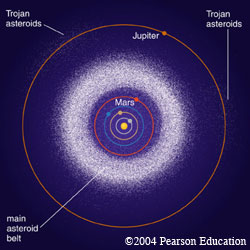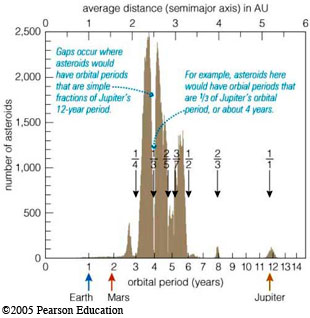
AsteroidsAsteroids
SUMMARY: Asteroids are small, rocky bodies that orbit the Sun much like planets, but are much smaller than planets. In fact, while comets are the size of a typical city, asteroids are about the size of a typical US state. Most asteroids are found in the asteroid belt.
General Characteristics of Asteroids
Measuring Asteroid Properties
Origin and Evolution of Asteroids
Missions to Asteroids
Related links
Related Lessons:
Are All Asteroids' Surfaces the Same Age?
General Characteristics of Asteroids

The asteroid Mathilde photographed
by the NEAR spacecraft on its
way to Eros
Asteroids are planetesimals left over from the birth of our solar system and have changed very little since the collapse of the solar nebula 4.6 billion years ago. The largest asteroid, Ceres, is about 1,000 km in diameter and has recently been promoted to dwarf planet status. Smaller asteroids are much more common.

The Trojan Asteroids
All asteroids orbit the Sun in the same direction as the planets. The vast majority of asteroids that have been catalogued are located in the asteroid belt between the orbits of Mars and Jupiter; however, not all asteroids are located in the asteroid belt. Two sets of asteroids, called Trojan asteroids, share Jupiter's 12-year orbit around the Sun. One clump of Trojan asteroids stays 60 degrees ahead of Jupiter and the other clump stays 60 degrees behind. There are also many renegade asteroids that have highly elongated or unusual orbits, some coming very close to Earth and other planets.
Measuring Asteroid Properties
Direct observations make it easy for scientists to research asteroids; however, spectroscopic analysis has given us many clues about the composition and properties of asteroids. The light we see shining from asteroids is actually reflected sunlight. The brightness of an asteroid in our sky depends on its size, distance and reflectivity.
We calculate physical size from the asteroid's angular size and distance. We determine an asteroid's distance from its position in its orbit. We determine reflectivity by comparing the brightness of light in the visible spectrum to the brightness of light in the infrared spectrum.
The light astronomers see shining from asteroids is reflected sunlight. Some of the sunlight is reflected and some is absorbed. When an asteroid absorbs light from the sun, it emits this absorbed light back into space in the infrared portion of the spectrum, in other words, as heat. If we compare the amount of visible light to the amount of infrared light, we can establish a ratio of the amount of incoming sunlight an asteroid reflects to the amount it absorbs.
We can also determine the surface compositions of asteroids through spectroscopy.
ASTEROID PROPERTIES IN REGIONS OF ASTEROID BELT:
- OUTER REGIONS: dark, show absorption bands from carbon-rich materials
- INNER REGIONS: more reflective, show absorption bands characteristic of rocky materials
- A small number of asteroids have heavier metals, such as iron
Some asteroids actually have other asteroids as their own orbiting satellites. This has been particularly helpful in measuring asteroid properties. By measuring the orbital period and orbital distance of the satellite, we can use Newton's version of Kepler's 3rd law to calculate the mass of the asteroid. From this, we can calculate the asteroid's density, and with this information we get an important clue of what the asteroid is made of. Check out a list of asteroids with satellites at Johnston's Archive.
Origin and Evolution of Asteroids
Asteroids are concentrated in the asteroid belt because of orbital resonances between asteroids and Jupiter. Asteroids with orbital periods that are a simple ratio of Jupiter's 12-year orbital period experience the same gravitational nudge on a regular basis. For example, asteroids with an orbital period of 6 years (½ Jupiter's period) will feel gravitational tugging from Jupiter when the asteroid and Jupiter line up in their orbits. These asteroids will eventually be pushed out of their orbits altogether. The same is true for asteroids with other simple ratios of Jupiter's orbit, such as 4 years (1/3 Jupiter's orbit) and 3 years (¼ Jupiter's orbit).

Orbital Periods of Asteroids
This graph shows the number of asteroids with various orbital periods, which correspond to different average distances from the Sun (labeled along the top). Notice the lack of asteroids with periods exactly ½, 1/3 or ¼ of Jupiter's — Jupiter has cleared gaps in the asteroid belt, knocking out asteroids that used to live there.
Once pushed out of the asteroid belt, these asteroids either crashed into a planet or moon or were flung out of the solar system altogether. Asteroids with unusual orbits are the result of Jupiter's gravity, tugging the asteroid out of its original orbit into a new one.
The constant tugging Jupiter's intense gravity has on the asteroid belt explains why no planet ever formed here. Essentially, the asteroids are pieces of a planet that never came to be — a failed planet. Orbital disruptions of planetesimals in this region prevented them from accreting into a full-fledged planet.
MIssions to Asteroids
The NEAR (Near-Earth Asteroid Rendezvous) spacecraft was launched in 1996. It was the first spacecraft to orbit an asteroid and eventually landed successfully on the asteroid Eros in 2001. The Johns Hopkins University Applied Physics Laboratory managed the mission for NASA.
The most recent mission to visit the asteroid belt was launched on September 27, 2007. The Dawn spacecraft will fly by Mars in 2009 on its journey to two of the largest asteroids in the asteroid belt, Vesta and Ceres. Dawn is scheduled to arrive at Vesta in late 2011, and scheduled to arrive at Ceres in early 2015.
Want to land on an asteroid? (video)
Where is Eros now?

